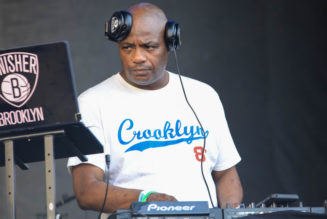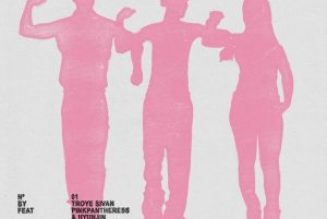
Stephen Sondheim had three rules when speaking about his own writing: Less is more, God is in the details, and content dictates form. While the first two are rather self-explanatory, when it comes to a career as storied as Sondheim’s, the third begs the question, how can you possibly describe this content?
Over his lifetime, Sondheim — who lived to be 91 years old, dying of cardiovascular disease in 2021 — was first and foremost a composer and lyricist of the musical theater. He wrote music and lyrics for 16 shows, counting the posthumously produced “Here We Are,” and lyrics solely for three (or four, depending on how you count) more, two of which — “West Side Story” and “Gypsy” — are among the most famous and highly-regarded productions of all time.
Even two years since his passing, his influence is still being honored. At the 2024 GRAMMYs, Sondheim’s likeness appears twice in the Best Traditional Pop Vocal Album category: for Vol. 3 of the popular Broadway concert series, Sondheim Unplugged (The NYC Sessions), and for Liz Callaway‘s tribute project, To Steve With Love: Liz Callaway Celebrates Sondheim. What’s more, the 2023 Josh Groban-starring Broadway revival of Sondheim’s famed musical “Sweeney Todd” earned a nod for Best Musical Theater Album. (“Sweeney Todd” won Sondheim a GRAMMY in 1980 for Best Cast Show Album, one of seven GRAMMYs he won in his lifetime.)
All of that barely begins to describe his accomplishments. Sondheim, a protégé of lyricist Oscar Hammerstein II, revolutionized the art form that his mentor helped to invent. Hammerstein and Richard Rodgers created “Oklahoma!,” considered one of the first examples of the “integrated musical,” a show where the music, the lyrics, the book, and the dances all work together to tell a story. Sondheim would take those lessons to heart, simultaneously expanding and blowing apart the structure.
Take his 1970 show “Company,” for example, which has no real plot at all, and is often referred to as a “concept musical.” It’s a series of vignettes, and it’s unclear whether they happen consecutively or are months or years apart.
That was only the beginning of his experimentation. He did a show featuring ghosts (“Follies”), a show about cannibalism (“Sweeney Todd”), a show about geopolitics (“Pacific Overtures”), a show about historical pariahs (“Assassins”), even a show where time goes backwards (“Merrily We Roll Along”). But no matter how far out he got, there was always coherence and heart at play. Everything about the songs his characters sang — the harmonic language, the musical style, the delivery, the melody, the vocabulary, the rhyme choices — was determined by the character and the story.
And what wonderful characters and stories they were. While his shows appeal to all ages, Sondheim’s best work is mostly for adults. His characters have known disappointment, love unattainable people, are not where they saw themselves in life, and have hard choices to make in complicated situations. Sometimes they make the challenging but necessary decision to “Move On”…and sometimes they kill a President. To take those complexities and make them sing, well, that’s the root of his genius.
Because Sondheim wrote both music and lyrics (and lived to his nineties), there are a nearly infinite amount of ways to experience his work. The best, of course, is to go out and see a show in person. Three of his shows are playing in New York right now (“Sweeney Todd,” “Merrily We Roll Along,” and “Here We Are”), and “Company” is currently on tour.
Aside from live theater, there are countless other ways to delve into the work of musical theater’s Shakespeare. Below, Sondheim’s career is broken down by seven categories, each of which include a mix of canonical classics and personal favorites. This is in no way comprehensive or definitive, so apologies for missing your favorite Gypsy revival cast album or Sondheim birthday concert. And away we go!
Cabaret Albums
Hearing Sondheim songs without the context of a show can be surprising at first. After all, everything about the material is meant for a particular moment in a specific story. And yet, hearing one singer interpret a range of numbers can be a revelatory experience. You can find different meanings (and in at least one case we’ll examine shortly, different lyrics!), and hear new interpretations.
The most famous interpreter of Sondheim is arguably Barbra Streisand, who recorded eight of his songs on her massively successful LP The Broadway Album (and three more on Back To Broadway). Her singing is (unsurprisingly) stunning, but what’s most notable is that she actually got Sondheim to write new material — to rework “Putting It Together” to make it about a singer instead of a painter, and to write a new bridge for “Send In The Clowns.”
English singer and actress Cleo Laine released Cleo Sings Sondheim in 1988, and she smartly got Sondheim’s longtime orchestrator Jonathan Tunick to conduct. So you can not only hear songs Tunick orchestrated in their original stage productions, you can also hear his arrangements of songs from before he and Sondheim started working together in 1970. Curious what a Tunick-orchestrated “Anyone Can Whistle” or “Evening Primrose” might have sounded like? You can get a taste here.
Several actors who have been in Sondheim shows have further honored his greatness by interpreting his material. Three quick examples: Bernadette Peters‘ superb Sondheim, Etc.: Live At Carnegie Hall; Mandy Patinkin‘s Mandy Patinkin Sings Sondheim; and Liz Callaway’s GRAMMY-nominated To Steve With Love (which includes a great version of a nearly-forgotten comic song from “Do I Hear A Waltz?“). Patinkin’s deserves special note because his only accompanist is the living musical theater jukebox pianist Paul Ford.
Books
The gold standard for books on Sondheim are the ones he wrote himself: the two-volume memoir/book of lyrics Finishing the Hat and Look, I Made a Hat. But if you’re not ready for that investment yet, there are other alternatives.
Meryle Seacrest’s Stephen Sondheim: A Life is a comprehensive and extremely readable single-volume biography. It manages to reveal some aspects of Sondheim’s life without feeling exploitative, and gives tremendous insight into both his work and the personal and professional relationships that informed it.
There are also a number of excellent books about the process of making individual shows; the two best come from opposite ends of the production spectrum. James Lapine, the book writer and original director of “Sunday In the Park With George,” created an oral history of the making of that show called Putting It Together: How Stephen Sondheim And I Created Sunday In The Park With George. All the way on the other side of the power structure, Ted Chapin, a gofer during the rehearsal process for Follies, turned his detailed journal entries into Everything Was Possible: The Birth of the Musical Follies.
On the more scholarly end, check out Joanne Gordon’s Art Isn’t Easy: The Achievement of Stephen Sondheim. If you really want to go all the way down the rabbit hole (and have a piano handy to play the musical examples), there’s Stephen Banfield’s extremely thorough Sondheim’s Broadway Musicals.
Movies
Turning a stage musical into a movie can be a tricky business; some of the greatest shows have been turned into middling films. The less said about the movie versions of “Sweeney Todd” or “Into the Woods,” the better (though it should be noted, in its defense, that Sondheim himself actually liked the former). The movie version of “A Little Night Music” is so forgotten that it’s basically impossible to find.
But there are some marvelous Sondheim-related films. Most famous, of course, is West Side Story, the 1961 movie of which was so popular — and acclaimed, winning a whopping 10 Academy Awards, including Best Picture, in 1962 — that it turned a successful but risky Broadway show into an immortal classic. It also inspired several remakes: not just the Oscar-nominated, Spielberg-directed one from 2021, but even a late-’70s Egyptian adaptation. The 1990 movie Dick Tracy contained five Sondheim songs, three of which were sung by Madonna, successfully introducing countless ’80s babies to his work.
The Last of Sheila contains no music, so it’s a bit of an oddity here. But Sondheim turned his lifelong obsession with games and puzzles into a fun murder mystery movie, co-written with Anthony Perkins. When you watch this 1973 gem, you might recognize some themes and ideas that would later show up in the Knives Out series, in particular Glass Onion (director/writer Rian Johnson has been very open about this).
Speaking of Perkins, he is the star of one of Sondheim’s great filmed musicals, the disturbing “Evening Primrose.” He plays a young poet who sneaks into a department store after hours so that he can have some privacy to write. What he discovers there is funny, heartbreaking, and ultimately horrifying. Think The Twilight Zone with songs written by a genius.
Finally, no mention of Sondheim and movies would be complete without D.A. Pennebaker’s 1970 documentary Original Cast Album: “Company.” It is, at root, Pennebaker and crew filming the recording of “Company”‘s cast album. But it’s so much more than that. It’s about how, as Sondheim once said, “Art isn’t easy,” and how the actors and musicians are trying — under several very watchful sets of eyes, including the composer/lyricist’s — to do the near-impossible in a very limited time. The film has become so iconic that the satirical series Documentary Now! did a hysterical 25-minute-long parody, complete with original songs that are loving send-ups of “Company” numbers.
Tributes/Anthologies
This category combines two similar types of projects. First is the tribute concert, where a bunch of notable singers come together on a single night and each do one or a few songs. Then there are anthologies, where a small group of performers put together a show using songs originally meant for other purposes. Sometimes they have plots, and sometimes they’re revues.
Among the best of the latter category is “Side by Side by Sondheim,” the 1976 revue in which three English singers strung together an extremely well-chosen and well-sequenced collection of songs. This was the show that really cemented Sondheim’s reputation in England, and justly so.
In the big one-night-only category, 1992’s Sondheim: A Celebration at Carnegie Hall is right up there at the top of the list. The array of talent at that one show is simply unbelievable, and will never be duplicated. Sondheim regulars like Betty Buckley and Bernadette Peters were there, but so were Liza Minelli and Billy Stritch; Patti LuPone; ballet legend Robert LaFosse; Glenn Close; Karen Ziemba; and even the Boys Choir of Harlem, all roped in to perform some of the finest songs in the musical theater canon.
Sondheim’s 90th birthday celebration is also noteworthy. Because it was in the early days of the pandemic, it was all done remotely. The actual live broadcast was a bit of a mess, with false starts and tech snafus (hey, who knew how to work Zoom in April 2020?). Luckily, Take Me to the World: A Sondheim 90th Birthday Celebration has been edited down and archived on Broadway.com’s YouTube page, and is well worth your time.
Revivals/Concert Productions
Another convenient bridging of categories here. Revivals are versions of shows done after the original production has stopped running. Concert productions are exactly that: people perform all the songs, with minimal (or sometimes no) staging or costumes. The amount of dialogue performed can vary wildly as well.
Among concert productions, the 1985 New York Philharmonic concert cast recording of “Follies” is justly the most well-known. This is in part because, due to budget restrictions, the original cast recording of “Follies” doesn’t contain most of the show’s music. So to finally have a full recording of all the material — performed by a who’s who of actors including Mandy Patinkin, Barbara Cook, Lee Remick, George Hearn, Elaine Stritch, Jim Walton, and even the legendary writing team of Comden and Green — well, it’s as magnificent as it sounds. There’s even a documentary to go along with it.
Another of the top concert recordings arrived a decade later: the 1995 concert version of “Anyone Can Whistle.” Angela Lansbury, who starred in the original Broadway production for all of the nine performances it lasted, comes back as the narrator. Bernadette Peters and Madeline Kahn are absolutely incredible, and have an all-time-great duet in the usually cut song “There’s Always a Woman,” gloriously restored for this production. If you really want to get deep into “…Whistle” (a flop at the time, but a fascinating show), there’s also a complete recording released in 2020 that is the closest thing to what you might have experienced in the theater in 1964 — it even restores all the dance music.
Revivals…well, where to start? A good place would be one you can see right now, “Merrily We Roll Along.” There is a superb cast recording of the production currently playing on Broadway with Jonathan Groff, Lindsay Mendez, and Daniel Radcliffe.
There have been a handful of major reimaginings of “Company” over the years. The best were a stripped-down version where the cast plays its own instruments, and a gender-swapped one where inveterate bachelor Bobby is portrayed as perpetually single woman Bobbie.
Points also go to the 2004 Broadway cast recording of “Assassins,” and not just because Neil Patrick Harris does such a great job. The whole album captures the project’s challenging beauty.
Original Cast Recordings
An original cast album of a Sondheim show will reveal countless treasures if you dig into it. It is often the best way to hear a show, since the actors are the ones who originated the roles, whether it’s Ethel Merman as the obsessed stage mother Mama Rose in “Gypsy” or Donna Murphy as the tortured Fosca in “Passion.”
The 1970s have a surfeit of treasures. To take a few not yet mentioned, there’s “Sweeney Todd,” with timeless performances by Angela Lansbury and Len Cariou; and “A Little Night Music,” perhaps Sondheim’s ultimate example of writing music for character. It’s nearly impossible to hear the show’s two main female characters as anyone else but the late Glynis Johns as the actress Desiree Armfeldt and Hermione Gingold as her mother.
If you haven’t already heard the original cast recordings of “Gypsy” and “West Side Story,” do so immediately. Both are iconic pieces of 20th century art. (Music for the former is by Jule Styne, and for the latter by Leonard Bernstein).
Proshots
Luckily, productions — many featuring the original casts — of many of Sondheim’s shows have been captured on tape, so you can see and hear them in their entirety. They are often referred to as “proshots,” a portmanteau of “professionally shot.”
“Pacific Overtures” works well as an album, but it really comes alive when you can see the gorgeous staging. “Sweeney Todd” gains extra comedy and menace in its proshot. There’s a New York City Opera version of “A Little Night Music” that is masterful. You can’t really understand “Passion” without seeing Donna Murphy. “Merrily We Roll Along”‘s complicated story becomes comprehensible when viewing the filmed revival.
But the most unmissable are two of the 1980s productions. There’s “Sunday In the Park With George,” a classic meditation on the life of the artist Georges Seurat starring Mandy Patinkin and Bernadette Peters; it was filmed for TV in 1986. Because this is a show largely about a painter and the creation of his most famous painting, actually seeing the show — literally seeing the painting come to life — is essential.
Arguably the most important of all, though, is the filmed play that introduced generations of children to Sondheim’s work. His fairy tale show “Into the Woods” was taped in 1989 (though not aired until 1991), and its frequent TV showings have made it a gateway drug for theatergoers ever since.
The show is not just a collection of children’s tales and songs. It uses the background of those stories to really delve into uncomfortable truths about parents and children, growing up, consequences, and what it really means to be good. Its themes, music, and sophistication, all while still being absolutely appropriate for, and speaking to, children, make it, as scholar Stephen Banfield wrote in 1993, “Sondheim’s finest achievement yet.”
That “yet” is a lot sadder now than it was when Banfield wrote it. But the show still stands as the epitome of a legendary writer and genius composer — one whose legacy and songs are already proving to live on past his lifetime.
How Lin-Manuel Miranda Bridged The Worlds Of Broadway & Hip-Hop









